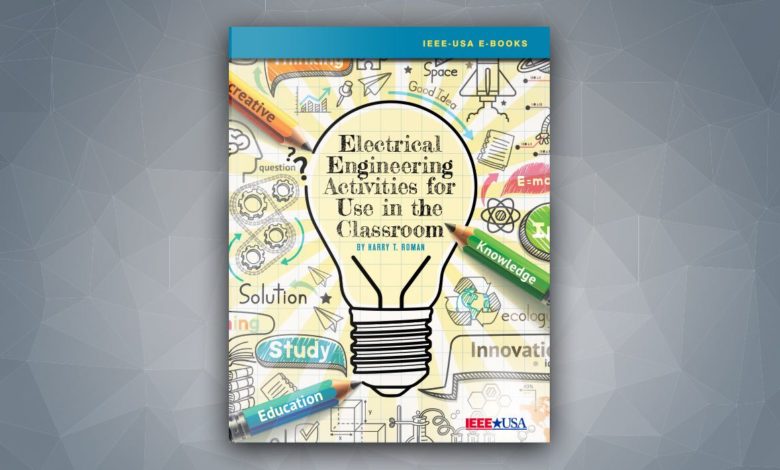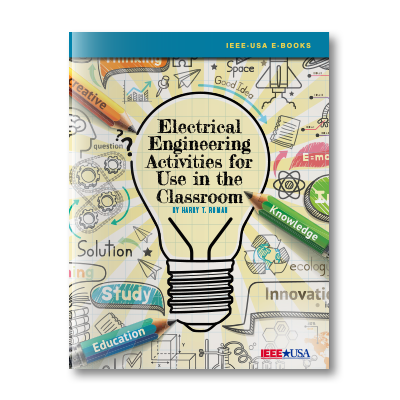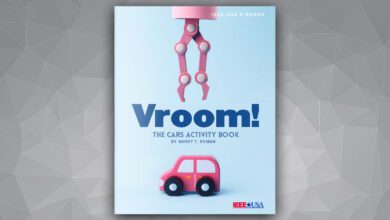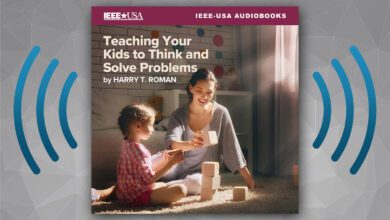

Electrical Engineering Activities for Use in the Classroom
FREE to Members
Non-Members: $2.99
Mark Van Doren, a wise educator if there ever was one, described teaching as “the art of assisting discovery.”
For years, the veteran engineer and educator Harry T. Roman has been assisting students of all ages — helping them to discover the excitement of real-world engineering and problem solving in the classroom. Now, this IEEE Life Senior Member has written an e-book for teachers and working engineers. It shows them how to foster broad-based, useful knowledge among students about the myriad aspects of electrical engineering.
Electrical Engineering Activities for Use in the Classroom is available free to all IEEE members. Non-members pay $2.99. Members — go to the IEEE-USA Shop; log in with your IEEE Account; add the book to your cart; then, download your free e-book! No special promo code required
Roman’s latest e-book is full of discussion topics and project ideas designed to challenge students in multiple areas of engineering. Whether it’s to encourage interest in the many disciplines within electrical engineering, or simply to foster a deeper awareness of engineering technology, he includes abundant suggestions for getting students’ attention and interest.
“Teachers and educators in higher education can use this book as part of the regular academic day,” the author explains in the introduction. “It can also be used in conjunction with STEM/STEAM or technology education classes, as well as for after-school clubs, or special academic projects.”
Of special note to IEEE members, Roman is also asking engineering professionals to share information about the e-book with teachers they know, who may be interested in it as inspiration for their students. In addition, he encourages engineers to offer being an expert visitor who can stop by the classroom, talk with students and answer their questions.
The wide range of topics and activities starts with an extensive list of discussion and activity suggestions to help introduce students to the engineering profession. For example, Roman suggests having them develop a definition of “electrical engineering,” after researching on the internet and visiting local engineering schools. Further, the author proposes inviting several university-level EE students to the class to discuss what — and how — their professors teach them.
Roman also recommends discussions about the significance of math to engineers; the importance of patents; and why codes and standards are important to the engineering world.
To challenge students with understanding the myriad of devices and systems that engineers have designed and built that benefit society, Roman provides a checklist of technological wonders students can explore. For example, the list includes how batteries work, and what the pros and cons of the technology are; the electrical utility system and its structure; and how cell phones work, with a comparison to the traditional, hard-wired telephones of the past.
In the chapter, Things to Think Deeply About, Roman provides a list of topics that offer an interesting perspective on electrical engineering technology. Subject areas range from solar energy technology, artificial intelligence — to the economic and environmental benefits of automobiles that generate clean, emission-free electricity.
The section, How Engineers Operate in Society draws on the author’s long experience as an R&D manager. Roman retired after 36 years with PSE&G, New Jersey’s largest utility company, where he directed and consulted on more than $100-million worth of projects and programs. Describing the parallel between engineering problem solving and the simplified STEM engineering design process taught in schools, he observes that both require integrated thinking and decision making.
Roman then provides the detailed process that engineers use to tackle new design and problem challenges in today’s world. Teachers can use these steps in the classroom, as an outline for students in simulating an engineering project.
As with all his writings, Roman advises that engineers must develop strong writing and speaking skills. This e-book is no exception. “Engineers frequently explain and propose things, and that requires excellent communication skills,” he writes. “I have never seen an engineer fired for incompetence, but I’ve seen careers stunted because an engineer could not speak or write well.”
Throughout his engineering career, Harry Roman was actively involved in education. He taught graduate-level R&D project management courses at the New Jersey Institute of Technology, and worked with schools throughout the state. Since retiring in 2006, Roman has published more than 70 teacher resource books, math card games, and science kits — all designed to teach creativity, invention, STEM, engineering and alternate energy topics in the classroom.
Roman currently works with teachers and their students in several N.J. communities, conducting special student project team challenges. He also co-teaches a course at Montclair State University about applying STEM techniques in the classroom.
Helen Horwitz is an award-winning freelance writer who lives in Albuquerque, N.M. She was with IEEE from 1991 through 2011, the first nine as Staff Director, IEEE Corporate Communications.






